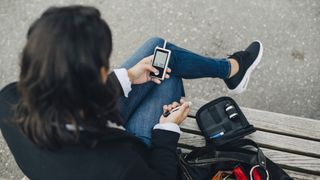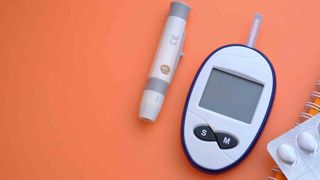Regularly checking your blood glucose levels is one of the main ways people with diabetes manage their condition, and learning how to use a blood sugar monitor at home is a vital step. Thankfully, many of the best glucose meters are designed to make testing faster, easier and a little less painful.
Although not everyone with diabetes will need to check their blood glucose levels at the exact same frequency (your doctor will guide you), regular testing can be an effective way to inform any changes to diet, activity and medication that might be needed.
There are a few different types of blood sugar monitors available to use. For example, a continuous glucose monitor (CGM) is a small sensor-based device, part of which you wear on your arm. Basic monitors require a fingerprick test instead. Here we’re focusing on how to use a blood sugar monitor with a basic design (so not CGMs).
Who needs to use a blood sugar monitor?
Blood sugar monitors are used to check that your blood sugar levels are within a healthy range. According to guidance from the American Diabetes Association, if your levels get too low, you can experience problems such as not functioning or thinking properly. If they get too high, this can cause severe damage to your body.
Most people who use blood sugar monitors have conditions such as diabetes, which occurs when your blood sugar is too high. However, these devices are also used by pregnant people who develop gestational diabetes (diabetes during pregnancy). They have also started popping up in the fitness world, used by people to see how food and heavy workouts affect their blood sugar.

How to use a blood sugar monitor: A step by step guide
First and foremost, it’s essential to follow the official guidelines produced by the manufacturer of the blood sugar monitor you’re using. These guidelines will tell you how to store the meter and how to use it.
Also ensure you test in a clean space with clean hands. Some blood sugar monitors might work slightly differently from others, so even if you have been using them for years, always read the instructions that come with your new device if you are switching brands or models.
These are the basic steps covering how to use a blood sugar monitor, which we’ve adapted from advice shared by the Centers for Disease Control and Prevention:
- Thoroughly wash your hands in warm water (encourages better bloodflow) and dry them.
- Make sure your blood sugar monitor is clean, positioned on a stable surface and ready to use.
- Remove a new testing strip.
- Using the lancing device included with your meter, prick your finger. If you need to, you can squeeze at the base of your finger and massage the blood down so that it flows better.
- Place a small drop of blood onto the test strip.
- Insert the test strip into the meter.
- Record your results once a reading appears, which is usually after around five seconds. Some devices digitally record the reading for you (smart meters do so via an app).
- If your device has a notes function, consider adding notes to the reading, such as what you ate or what exercise you did prior to the reading.
- Throw away the used lancet and test strip.
Make sure you keep your readings and notes in a safe place so that you can share them with your doctor or healthcare professional the next time you see them. Looking through past readings can help you establish your average levels, as well as pinpoint potential causes for spikes and crashes.
How to use a blood sugar monitor: Alternate site testing
The easiest way to use a blood sugar monitor is to use a lancet to take a small drop of blood from your finger. There are many capillaries in your fingertip, so it makes getting a blood sample easier and a touch less painful.
But there are many reasons why fingerprick testing might not work for some people all of the time. In this case, you can take a blood sample from your thigh, your arm, or any other approved site listed in the instructions for your monitor.

Taking a drop of blood from an alternate site works in much the same way, but you need to check the instructions that come with your blood glucose monitor because some only work with a tiny drop of blood and should only be used at certain times.
What’s more, according to Diabetes UK, the results might not be as accurate when you test at alternate sites. That’s why you should try to use your fingertip where possible and discuss with a healthcare professional how to get a precise reading from anywhere else on your body before you attempt this.
7 tips for successful blood sugar testing
There are some easy steps you can take to ensure that your testing goes as well as possible, and to reduce some of the pain involved with routine fingerprick tests. Follow these steps the next time you use your device and you should see the results:
Tip 1
To reduce your chance of infection, don’t share your monitor or lancet with anyone.
Tip 2
Keep your blood sugar monitor with you at all times, including all of the necessary equipment, like lancets and test strips. That way, you don’t have to wait to take a reading.
Tip 3
Make sure you have enough testing strips and stock up if you need to. You should also make sure your test strips are in date and keep them away from sunlight and moisture.
Tip 4
Chat to your healthcare professional about how often you should test your blood glucose, then create a schedule. Setting a timer on your phone is an excellent way to make sure you stick to it.
Tip 5
To reduce pain, use the lancet to take a drop of blood from the side of your finger rather than the tip. Why? Because there are fewer nerve endings on the side, which means it tends to be less sensitive.
Tip 6
Alternate the fingers you take samples from each day so they get a rest and you’re less likely to experience pain.
Tip 7
Make sure your hands are clean before you take a sample. This will reduce infection but washing your hands under warm water can also increase blood flow, which will make it easier to take a sample.
For more health content, take a look at our guide to the best health insurance companies, plus our roundup of the best Medicare Part D plans for help with medicine costs.

